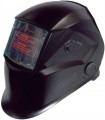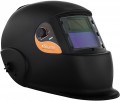Turn-on time
The turn-on time of the filter in the chameleon mask (see "Type"), in other words, the time between striking the arc and darkening the filter to the operating level.
From a safety point of view, the turn-on time should be as short as possible: the faster the "chameleon" works, the less bright light from the arc enters the welder's eyes. On the other hand, reducing the reaction time affects the cost of the product. So for relatively small volumes of work, it is quite acceptable to use relatively “slow” masks — for
100 μs or more(especially since even in the simplest models, the reaction time does not exceed 1200 μs, while theoretically the maximum allowable value is 2000 μs). But for more serious use, you should pay attention to more "fast" options; nowadays, you can find masks with response times
from 75 to 100 µs,
from 50 to 75 µs, and even
less than 50 µs.
Filter class
Class is a complex indicator that determines the overall quality of the light filter in a chameleon mask (see "Type"). The class is indicated by 4 numbers, each of which describes a specific optical parameter. So, the first number indicates the overall clarity and lack of distortion; the second is the degree of light scattering; third — uniformity of blackout (presence/absence of visible blackout spots); the fourth is the angular dependence (how much the filter brightens when the angle of view deviates from the perpendicular). In each case, the larger the number, the worse this parameter is. The perfect indicator is considered to be 1/1/1/1, but in fact it is very difficult to achieve an perfect angular dependence, and there is no need to. Therefore, an indicator of 1/1/1/2 is considered quite sufficient even for a high-end professional filter.
Filter viewing area (WxH)
The size of the transparent part of the light filter — the "working window", the area through which the welder sees the place of work. A larger working window provides ease of use and a wide field of view, but it significantly affects the cost of the mask and somewhat reduces the strength of the light filter.
Filter cartridge dimensions (WxH)
The overall dimensions of the light filter for which the mask is designed, taking into account the working window, protrusions for mounting, batteries, sensors and other structural elements. This indicator is especially important for models that are not equipped with light filters: without knowing the size, it is very difficult to choose the right cartridge. In other cases, data on the size of the cartridge is needed mainly when looking for a replacement for a failed colour filter.
Optical sensors
Optical sensors determine the filter response speed. They respond to sudden changes in lighting and arc flicker — characteristic signs of the start of welding work. The more sensors in the mask design, the less likely the filter will open during welding. To better capture the difference in radiation, sensors are often placed at different corners of the mask.
Grinding mode
A special mode of operation of the chameleon mask, in which the light filter sensors are completely turned off — thus, it constantly remains transparent and does not respond to any flashes. This mode is useful for jobs that can produce fairly bright flashes of light, but do not require dimming. A classic example of such work is grinding with a “grinder” or a machine tool, when sparks can fly from the workpiece; hence the name of this function —
"grinding" mode.

